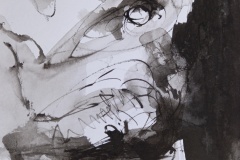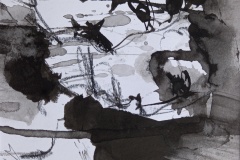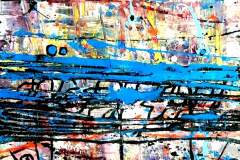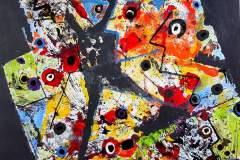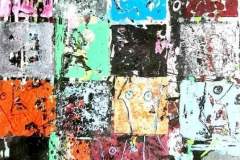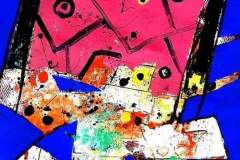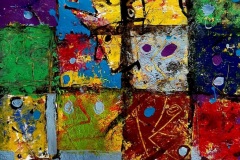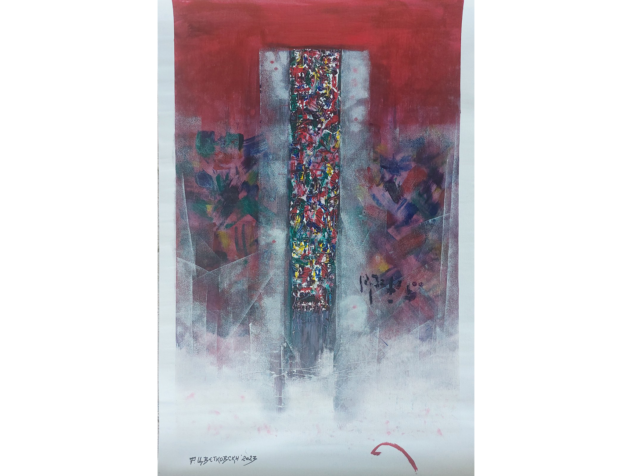Artists in Residence Series: Agron Abduli & Burim Ukici
DROWNED SCREAM
Agron Abduli is a painter and professor at the Faculty of Arts at the University of Tetova. Throughout his academic formation, and later also, Agron has maintained an affective rapport with the gender of the portrait, for later to be precisely this gender, the origin, the forming magma of his creativity.
His work has a conceptual continuity that has been consolidated over time and has clearly defined the artistic profile of the author. It breathes within a healthy pictorial environment and narrates the invisible strands of communication between figure/portrait and its reduction, persistence or the tendency of the author to overcome the limit of figurative expression and seek another distinctive identity, a reduced and abstract style, as their heads and faces lose their distinctive features and shapes, protracted and transformed to the extent that they are hardly recognized as the heads or portraits.
Agron has built an excessively personal, analytic and meditative system to confess what happens inside it, to translate into painting images of realities plaguing on his feelings and consciousness. Making a radiograph of human being and delving deeply into its sensitivity, Agron through his paintings brings troubled, tormented portraits/human faces, full of sadness and anxiety, which reflect the nature of a tumultuous time, a drama full of tension of the individual.
His paintings resemble the flooded reverberation into the void of an invisible insideness.
They form a cycle, a single phrase, but are independent of each other. They live on their own, inside a scenario that has no beginning or ending, but consists of a multiplicity reference points that interfere with each other.
In coloristic treatment, Agron is generally restrained. He is prone to graphics resolution, passing to tableaus nearly graphics, backgrounds where dark tones prevail.
His painting goes and falls over the black fabric. “Strikes” with color are controlled and seek to take out from shade the drama build to stay hidden to the eyes of others.
The technique of building paintings with simple surfaces, with a soft monochromy and controlled contrasts is very important, because it begins and deeply becomes a substance.
The artistic language and the subject of Agron’s works require an artistic culture, meditation and concentration. His painting comes as a personal experience and goes beyond the initial idea which has conceived it.
This cycle, this corpus of works, raised painting after painting, consolidated over time, finds its source to the deep research and full of gravity that the author does to his subject.
Text by Nora Halimi
Burim Ukici’s painting is magical, mystical, while at the same time real, clean, clear, calm. Like kisses between dreams and reality, like meetings of prose and matter.
In the paintings he brings more than evocation than observation, more emotion than reality, more nostalgia and an inner need for pillars and identity. This means that Burim Ukici paint what he likes and what comes from within him – the impression of internal developments. The composition and stroke are also conditioned by internal feelings. The expression on the canvas would never have produced “poetry” if this condition had been not previously felt deep inside.
The art structure is partially lost under the pressure of pure painting poetry, known for his coloristic expression.
The artistic forming continues in the spirit of expansion of abstract content. Painting every moment that inspired him to create a painting, not an illustration . With his distinctive and specific colors, red, green, yellow, black, he creates a characteristic harmony of color with which his paintings speak of temporal sequences, of the space and the values of existence that ennoble the psyche of each individual. The primary emphasis is placed on the emotionality created by the dense colorful descriptions, the quiet expressionist intonation and imagination of painting layers.
The main component in painting Burim Ukici’s painting lies in the sincere expression of richness of color, in the boldness of the formal conception and in keeping pace with temporal artistic tendencies.





